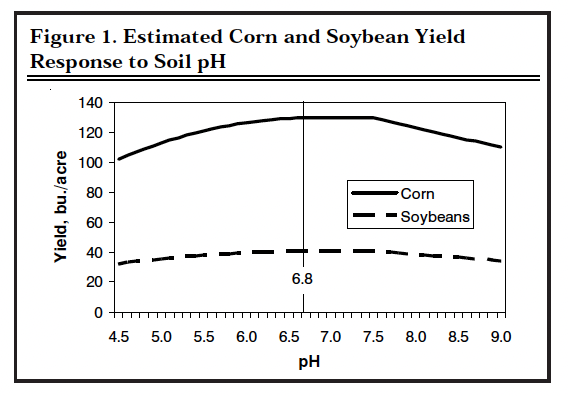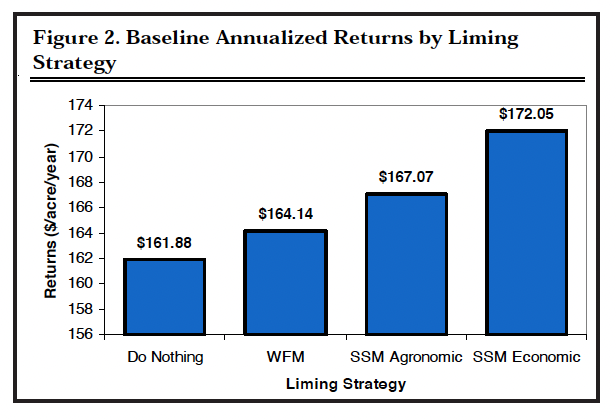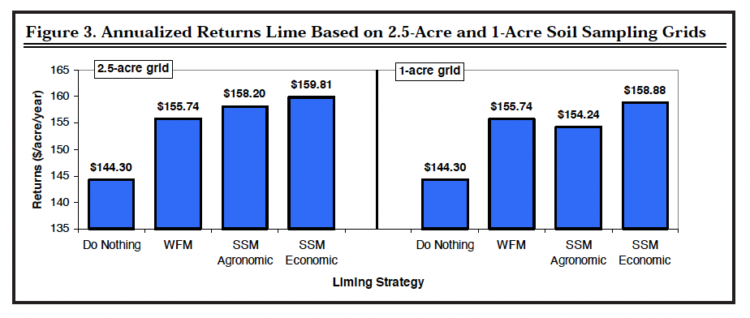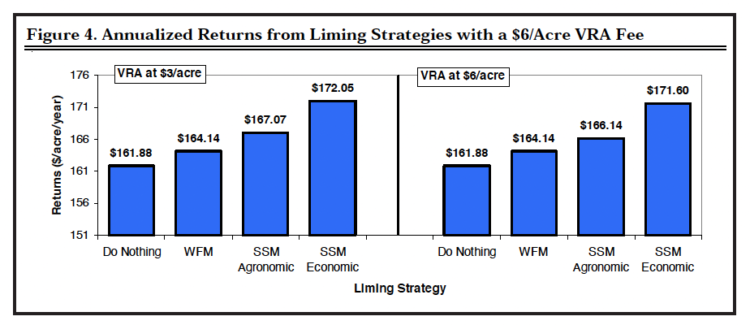Economics of Site-Specific Lime Management in Indiana
September 13, 2002
PAER-2002-10
Bongiovanni, Graduate Student and J. Lowenberg-DeBoer, Professor
Soil pH is the most spatially variable among the manage-able characteristics of Indiana soils. It is not unusual for soil pH tests to vary from 4.5 to almost 8 within a field. The optimal range for most Indiana crops and soils is between 6.0 and 6.8. Liming for the field average pH can result in significant yield losses because some areas are over limed and others receive too little. Site-specific lime application attempts to vary applications within fields so that pH in each area is corrected to the optimal range. Unfortunately, site-specific lime management, with intensive soil tests and variable rate applications, costs money. The study reported here estimated returns to alternative liming strategies based on representative soil test data from fields in southwestern and east central Indiana. The crop response to liming was estimated from published trials on several experiment stations in the U.S. The goal was to determine if reduced lime application and yield gains from site-specific lime management could cover the extra costs.
In Indiana, variable rate application (VRA) of lime is often considered a good place to start site-specific management (SSM). In addition to the variability of soil pH, there are several factors that favor VRA lime.
- The equipment cost is modest because conventional lime spreaders can be retrofitted relatively inexpensively to do VRA.
- The optimal pH range is relatively narrow, and yields decrease when the pH is too high. This is unlike phosphate and potassium, which do not usually show yield decreases because of overapplication.
- Though lime itself is relatively cheap and plentiful in Indiana, liming fields can be an expensive exercise because of the large quantities of lime required to change pH.
Production Strategies
Two SSM lime strategies were studied. First, SSM using agronomic recommendations
(SSM-Agronomic) was studied. This approach grid samples the field and applies the recommended rate of lime to the individual grid cells using the agronomic recommendation rules from the Tri-State Fertilizer Recommendations.
Second, SSM with the economic rule (SSM-Economic) was considered. This approach is similar to SSM-Agronomic, but uses the economic rule, marginal value product equal to marginal factor cost (MVP=MFC), to determine the recommended rate of lime to the individual grid cell. SSM-Economic requires information on the crop response to pH.
To evaluate profitability, the SSM strategies are compared to the whole field management (WFM) strategy, considered here as the baseline case. WFM requires a composite soil test, resulting in an average pH for the field and a single rate for lime application, using the agronomic recommendation rule. This is the most common current practice in the state. The option of doing nothing is also reported for comparison purposes as the control case.
The methodology involves a spreadsheet model of a corn and soybean rotation over a four-year period. Four years is a typical soil sampling cycle. A spreadsheet model was used, because field trials to answer the question of VRA profit-ability for lime would take long-term field studies (at least four years and probably eight). By the time the studies were completed, many Indiana producers would have already made their decision about VRA lime. The spreadsheet model permits timely results that can help producers make those decisions.
The estimates of crop responses to lime are shown in Figure 1 as relative yields. The maximum yield of both corn and soybeans was obtained at a pH of 6.8. The negative effects on yields at high pH levels were modeled using a weed science rule of thumb of a 1% decline in yields for each one tenth (0.1) increase in pH over 7.5.

Figure 1. Estimated Corn and Soybean Yield Response to Soil pH
The spreadsheet model was used to estimate returns to alternative liming strategies for 22 fields in the east central and southwestern Indiana that had been grid soil sampled. The estimate assumes that lime is custom applied. The cost for VRA is $3/a higher than uniform application. Because the corn and soybean rotation liming benefits vary from year-to-year, returns over the four-year period were annualized to provide a single measure of profitability for each liming strategy. An annualized value is the constant annual cashflow that has the same net present value as a series of irregular cashflows. The discount rate used in annualization was
10% annually.
Results
The average annualized returns for all study fields show that VRA lime has substantial benefits (Figure 2). Under baseline conditions, the average benefit of SSM agronomic over WFM is almost $3 per acre (Figure 2). This is greater than the$2.26/a average gain in moving from a “do nothing” approach to WFM for these fields.

Figure 2. Baseline Annualized Returns by Liming Strategy
With more information about pH response, returns could be increased even further. The SSM economic strategy shows an annualized benefit of $5.84/a over the SSM agronomic and $7.91/a over WFM.
Because six of the fields in south-eastern Indiana had information from 0.11-acre grids, it was possible to do a sensitivity analysis on grid size. With 1-acre grids, four of the fields require some lime.
The results with 2.5-acre grids are similar to those shown for the whole 22-field sample. SSM agronomic showed about a $2.50/acre benefit over WFM (Figure 3). With a 1-acre grid, the cost of soil sampling more than wiped out the benefits of SSM agronomic. SSM economic shows much reduced benefits with the 1-acre grid.

Figure 3. Annualized Returns Lime Based on 2.5-Acre and 1-Acre Soil Sampling Grids
Custom application fees for VRA vary widely. For this study, the baseline assumption was a $3/acre additional fee for VRA. With a $6/acre charge for VRA lime, annualized benefits drop slightly, but both SSM strategies continue to be more profitable than WFM (Figure 4). The decrease in the annual return is less than with the $3 VRA cost because the fee is spread over the four years.

Figure 4. Annualized Returns from Liming Strategies with a $6/Acre VRA Fee
Conclusions
The results indicate that with either the SSM agronomic recommendations or the economic optimization, VRA of lime is profitable as a stand-alone technology on the Indiana fields studied. The overall results indicate that SSM-Agronomic provides an increased annual return by almost $3/acre over WFM and that SSM-Economic provides an increased annual return of $7.91/acre over WFM. Because of the extra cost of sampling, returns are higher on a 2.5-acre grid than on a 1-acre grid. Sensitivity testing indicates that SSM strategies for lime are more profitable than WFM over a wide range of prices and conditions.
For More Information:
Bongiovanni, R. and J. Lowenberg-DeBoer, “Economics of Variable Rate Lime in Indiana,” Precision Agriculture, 2 (2000), p. 55-70.
Vitosh, M, J. Johnson and D. Mengel, Tri-State Fertilizer Recommendations for Corn, Soybeans, Wheat and Alfalfa, Michigan State University, Purdue University and Ohio State University, Extension Bulletin E-02567, 1995.
